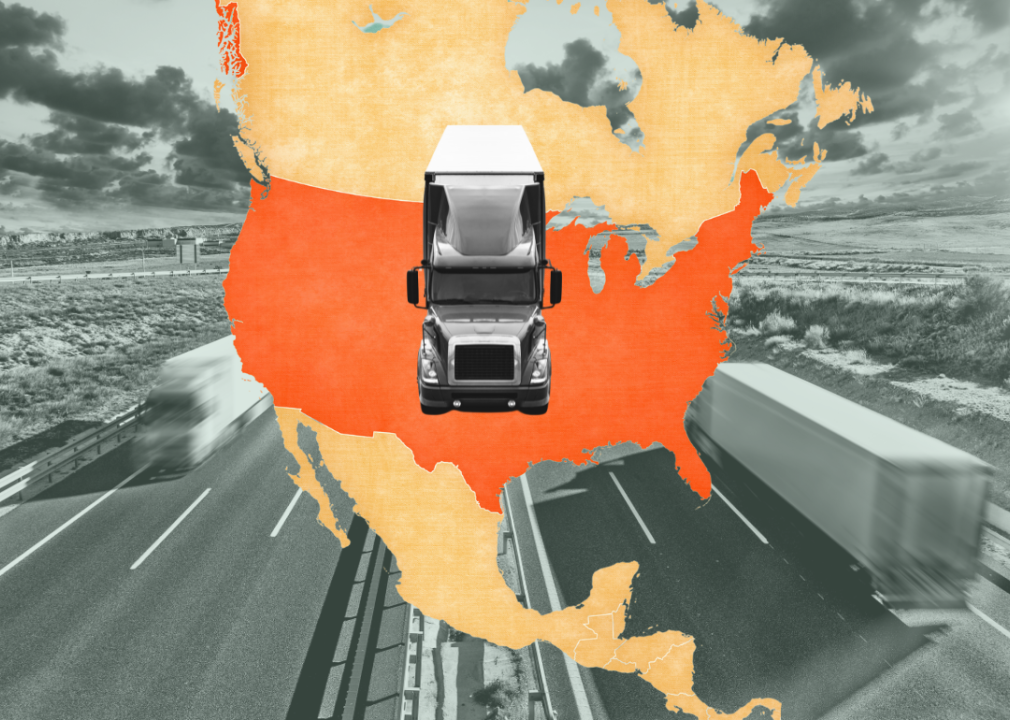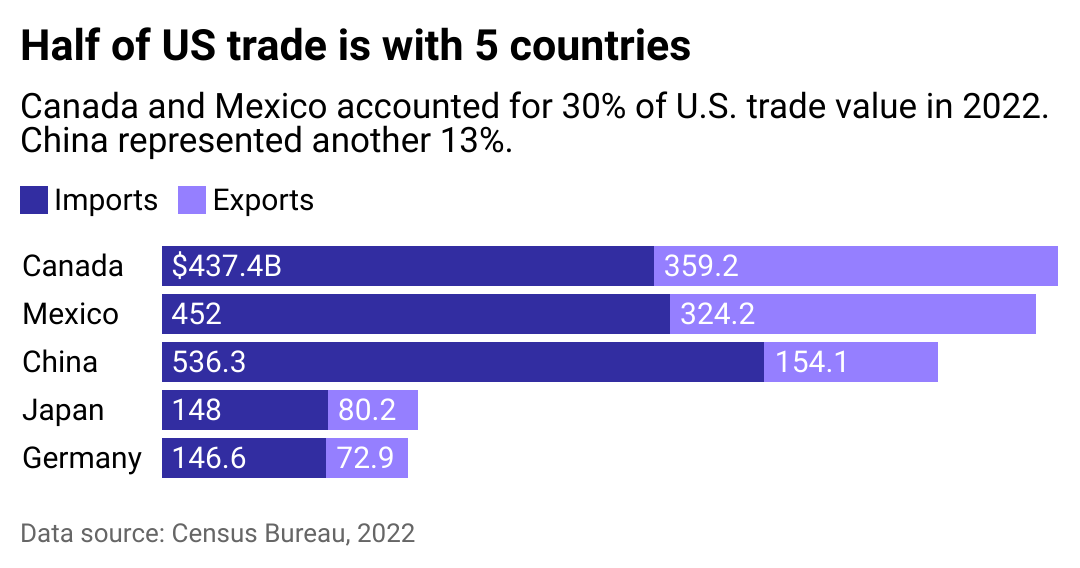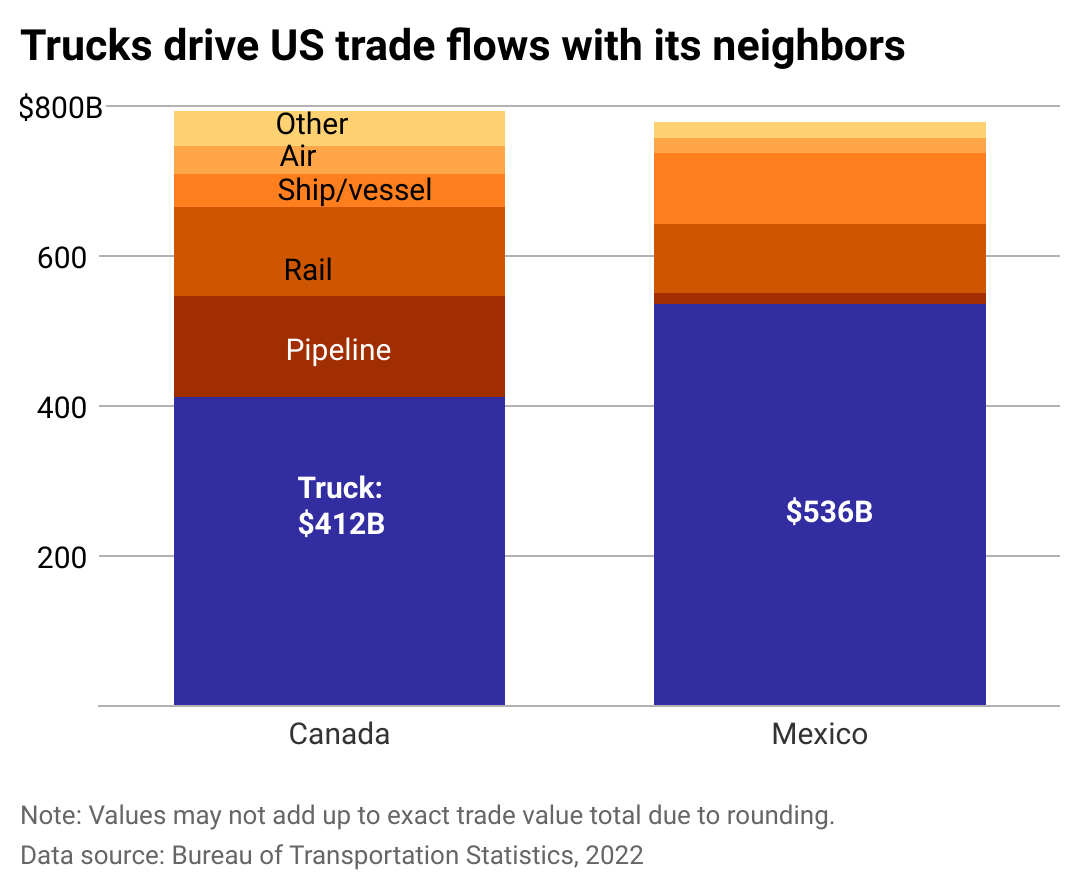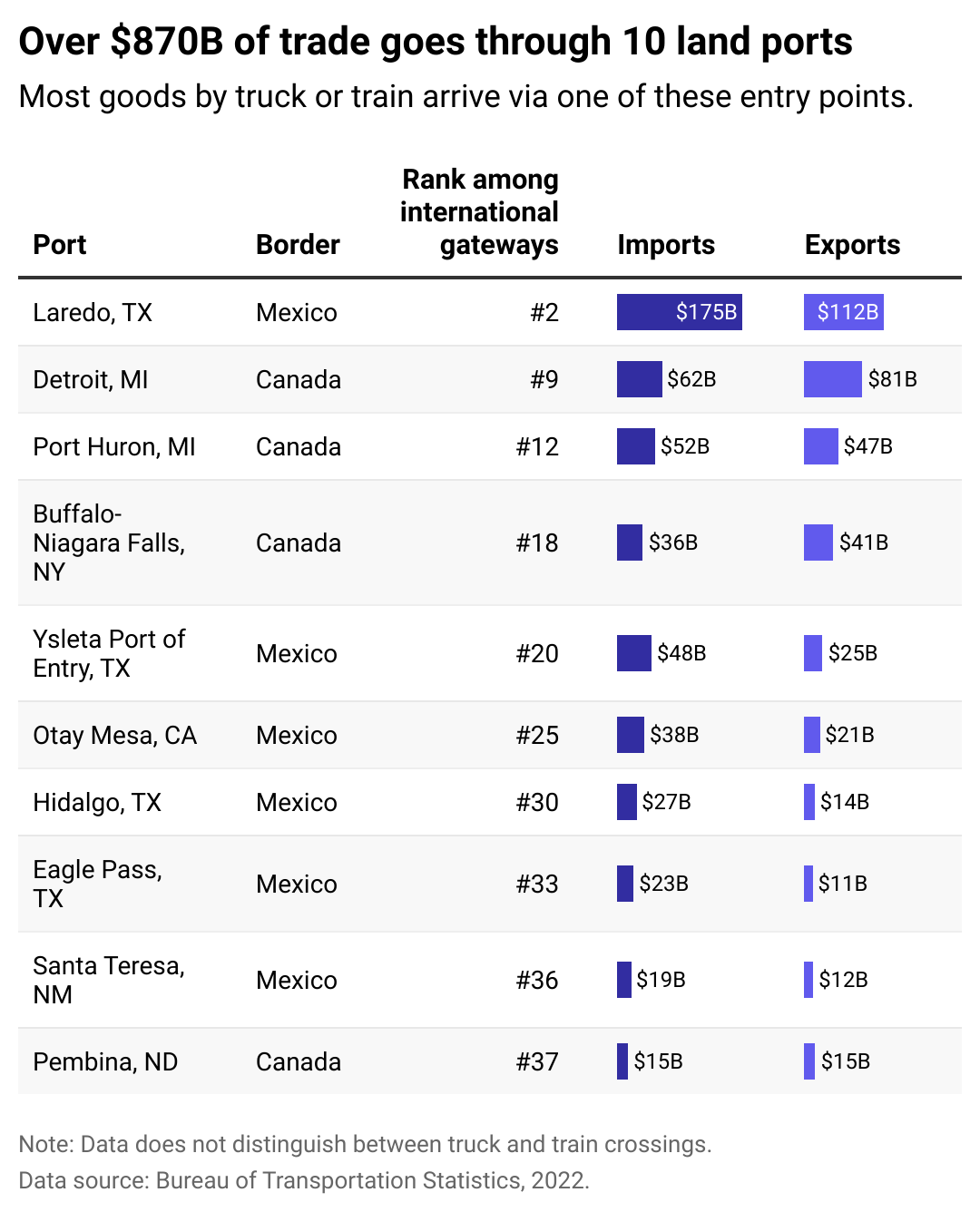How trucks connect the US with two of its biggest trading partners

Photo Illustration by Stacker // Canva
How trucks connect the US with two of its biggest trading partners
An image of a truck superimposed over an orange map of North America.
They come rumbling down the highway, crossing bridges and international borders. They bring life-saving drugs, food for the kitchen table, and that random clothing fad that will be out of fashion mere months later.
Trucks are ubiquitous on American roadways. However, they’ve become increasingly important in trade with its neighbors, Mexico and Canada, as relations with China cool and the United States government encourages “nearshoring,” the practice of moving part of a company’s production to nearby countries with similar time zones. In 2022, there were about 5.5 million truck crossings at the U.S.-Canada border and 7.25 million at the U.S.-Mexico border.
Trade with Canada and Mexico (much of it via land instead of water or rail) has recently outpaced trade with China, which has long dominated the international trade landscape.
Truck Parking Club used data from the Bureau of Transportation Statistics and Census Bureau to explore U.S. freight trade with Canada and Mexico.
![]()

Truck Parking Club
Geopolitical pressures shift top trading partners
Bar chart showing half of U.S. trade is with five countries. Canada and Mexico accounted for 30% of U.S. trade value in 2022. China represented another 13%.
For the first time in decades, Mexico overtook China in the number of goods bought and sold to the U.S. in 2023. Centers for Disease Control and Prevention data shows that Canada claimed first place, taking the title of top trade partner.
The shift follows the push to embrace nearshoring. The United States’ dependence on the fragile worldwide supply chain came into focus during the coronavirus pandemic. Then, shipments of vital supplies like computer chips, personal protection equipment, and medication faced shipping backlogs and caused shortages worldwide. Nearshoring policies aimed to encourage suppliers to keep materials and the manufacturing processes geographically closer to the U.S.—not only to have them readily available in case of an emergency but to encourage the economic growth of the U.S. and its direct neighbors.
The trade war between the U.S. and China that began in 2018 and the subsequent Russian invasion of Ukraine worried U.S. investors. They recognized the war would bring more sanctions and devolve international business relations and figured it was better to transition some manufacturing to North American soil and U.S. allies.
Increased tariffs on Chinese goods imposed by the Trump administration and carried through the Biden administration also made an impact, forcing companies to look for suppliers and manufacturers closer to the United States. The international North American Free Trade Agreement and its successor, the United States-Mexico-Canada Agreement, imposed strict rules outlining what percentage of an item must be produced in North America. For example, under the USMCA, 70% of a vehicle manufacturer’s steel and aluminum purchases by value must originate in North America, and those companies that don’t meet the mark may face additional tariffs.

Truck Parking Club
The outsized role of trucks in US trade
Column chart showing how trucks drive U.S. trade flows with its neighbors. Trucks accounted for over half of the value of traded goods in both Mexico and Canada in 2022.
Most trade among the U.S. and its neighbors occurs through trucking, and the percentage of goods arriving on trucks continues to increase. According to the BTS, $948.0 billion in goods were shipped via truck from and to Canada and Mexico, while goods shipped via trains accounted for $210.2 billion in 2022. The value of truck freight increased by 14.5%, while rail increased by 12.7% between 2021 and 2022.
The U.S., Canada, and Mexico are each other’s largest trade partners for oil, energy, automobiles, electronics, and agricultural goods—and it’s common for materials to be procured from one country, produced into goods in a second, and then marketed and sold in a third.
According to the BTS, U.S. trade with Canada and Mexico accounted for almost a quarter of the country’s international trade. There is hope these ties will economically lift the whole continent and establish stronger labor policies. The USMCA fast-tracks labor dispute processes and requires manufacturers to allow their employees to unionize, leading to higher wages. It pushes Mexico, in particular, to enforce existing employee rights, according to a Brookings Institution analysis.

Truck Parking Club
Laredo’s rising prominence in the world of international trade
Table showing top 10 land ports in the U.S. Over $870 billion of trade goes through these ports. Laredo, Texas is the highest land port and also the #2 highest international gateway overall.
The key to this intracontinental trade is the land ports in the U.S., where trucks stop to have their goods and materials inspected and tracked.
Laredo, a sprawling city in Texas just over the Mexican border, is the second-largest international gateway for trade in the U.S. It has sometimes bested even the ocean ports of Los Angeles and Long Beach, California, which have long been the top import location.
“The Southern California ports grew exponentially during an era of globalization centered on China,” New York Times economics reporter Peter Goodman explained. “Laredo appears primed to assume a similar role in the anticipated next phase of globalization, one centered on regional supply chains, with American companies forging greater reliance on Mexico and Central America.”
Local government officials and business leaders say Laredo’s infrastructure is already lagging behind the demand. Freight entrepreneurs are scrambling to buy land and build warehouses into way stations for goods. Plus, there are plans to streamline the customs process by enacting just one inspection for American and Mexican authorities and expanding the World Trade Bridge so trucks can more quickly pass over the Rio Grande river into Texas.
According to the Joint Transportation Committee, demand for truck parking will likely continue as international border crossing inspections cause bottlenecks and unpredictable wait times. Truckers will try to avoid the traffic by crossing the border at odd hours and planning their mandatory rest periods in the country they cross into.
In this new era of nearshoring, a competitive edge can be as simple as having enough parking for trucks while they wait to drop off their goods. Afterward, they will turn around, go home, and pick up their next load, creating the next link in the ever-evolving global supply chain.
Story editing by Carren Jao. Additional editing by Kelly Glass. Copy editing by Paris Close. Photo selection by Michael Flocker.
This story originally appeared on Truck Parking Club and was produced and
distributed in partnership with Stacker Studio.
